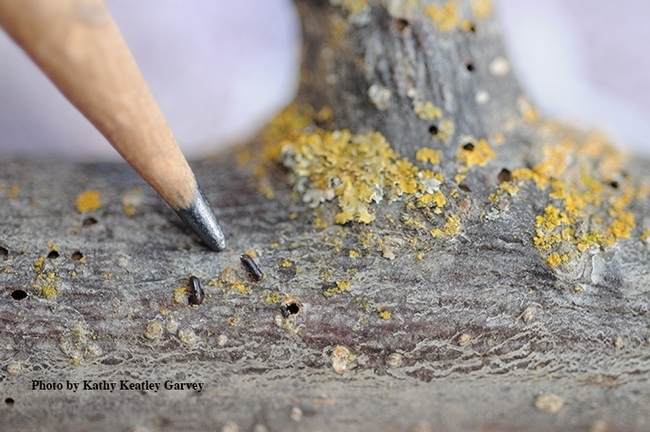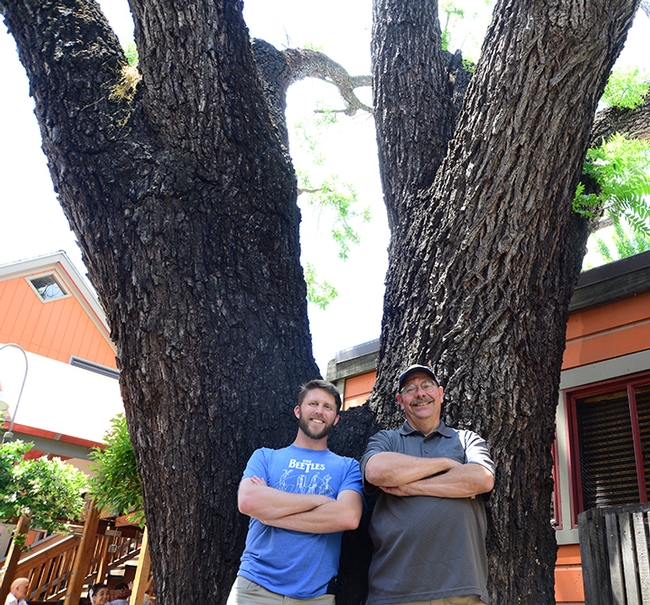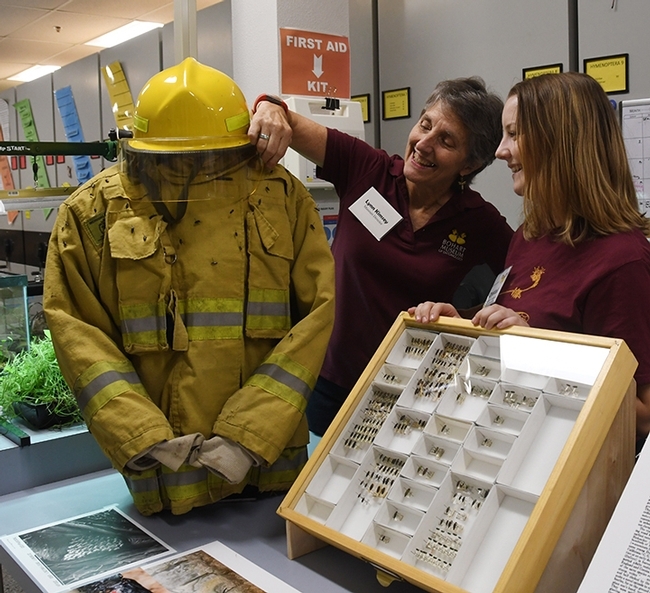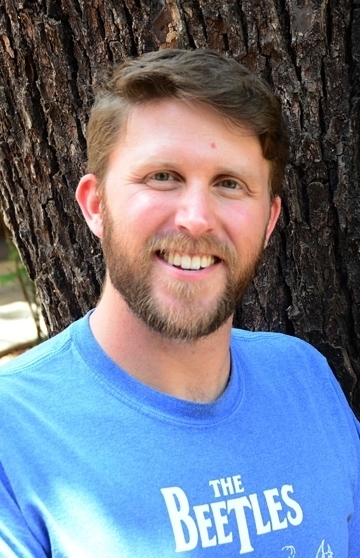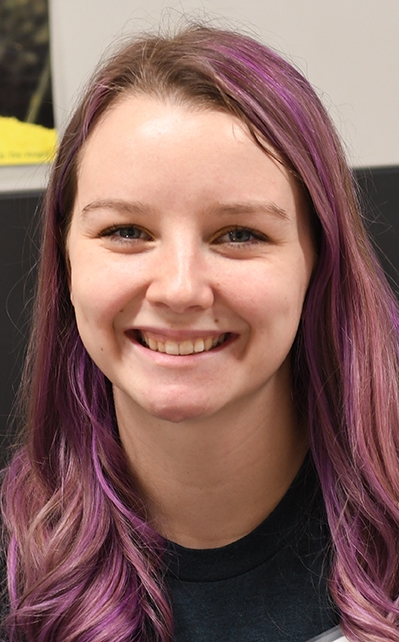Steve Seybold specialized in the chemical ecology of forest insects.
Jackson Audley, who received his doctorate in entomology in 2019, and
Crystal Homicz, a doctoral student in entomology, co-authored two research papers in the
Journal of Agricultural and Forest Entomology:
- "A Study of Landing Behaviour by the Walnut Twig Beetle, Pityophthorus juglandis, Among Host and Nonhost Hardwood Trees in a Northern California Riparian Forest" (https://doi.org/10.1111/afe.12385).
- "Walnut Twig Beetle Landing Rates Differ Between Host and Nonhost Hardwood Trees under the Influence of Aggregation Pheromone in a Northern California Riparian Forest" (https://doi.org/10.1111/afe.12410)
The walnut twig beetle, in association with the fungus, Geosmithia morbida, causes the insect-pathogen complex known as "thousand cankers disease," which wreaks havoc on walnut trees. The insect, measuring about 1.5 millimeters long, is smaller than a grain of rice.
The two complementary papers shed more light on the invasive pest. Both papers list Seybold, a pioneering scientist in the study of the beetle and the newly discovered disease that it causes, as a co-author.
"The first study is one of few bark beetle host selection studies conducted without the use of semiochemical lures," Audley said. "Together, both studies provide strong evidence for directed flight host searching and in-flight, host discrimination behaviors by Pityophthorus juglandis. These papers highlight sources of and provide an ecological context for potential non-host, volatile compounds that may be of use in semiochemical repellents to protect walnut trees from attack by P. juglandis."
Jackson Audley, co-author
"Steve was a giant in the forest entomology community, particularly in the field of bark
beetle chemical ecology," Audley said. "He was a great mentor and I am fairly confident I would not be half the scientist I am today without his guidance."
SaidHomicz: "Our papers highlight that the walnut twig beetle is highly skilled at discerning hosts in flight. Even when we attempt to lure them to non-host trees by tricking them with aggregation pheromone, more often than not, they correctly identify their host tree. This shows the beetle has evolved to be highly tuned into its environment and the volatile profiles of its host species. Yet another example of how complex and advanced the insect olfactory system is! Future work may focus on identifying repellent chemical compounds released by the non-host tree species included in our studies."
Crystal Homicz, co-author
Seybold, who died Nov. 15, 2019 of a heart condition, was a researcher at the Pacific Southwest Research Station, USDA Forest Service, Davis, where he specialized in the chemical ecology of forest insects. He was also a lecturer and researcher with the UC Davis Department of Entomology and Nematology and mentored students.
Richard Bostock, distinguished professor, UC Davis Department of Plant Pathology, served as a co-author on both papers (in addition to Audley, Homicz and Seybold).
First Paper: A Study of Landing Behavior
The abstract:
- The host selection behaviour of the walnut twig beetle, Pityophthorus juglandis, was assessed by monitoring the landing rates of the beetles with sticky sheet traps on the host and nonhost hardwood branches.
- Sticky sheet traps were deployed for 8 weeks from 6 June to 2 August. 2017 in the Putah Creek Riparian Reserve, Davis, CA. Branches from host northern California black walnut, Juglans hindsii, were paired with branches from six nonhost hardwood species.
- The landing rate of P. juglandis (412 beetles trapped/8 weeks; 389 on host branches, 23 on nonhost branches) was significantly greater on the host branches for all nonhost hardwoods except Populus fremontii. Proportional comparisons of beetle presence also revealed a significant preference for the host branches compared with all but two nonhost species, Acer negundo and P. fremontii.
- Capturing P. juglandis without the use of an aggregation pheromone was a rare event, underscoring the difficulty of studying the initial phases of host selection behaviour in bark beetles. Unbaited funnel traps adjacent to selected host trees in the experiment only captured five individuals over a 19-week period. None were captured in traps adjacent to nonhost trees.
- This study provided evidence that P. juglandis discriminates between host and nonhost branches while in-flight. This directed flight behaviour is likely informed by the recognition of both host and nonhost volatile cues.
- This study established an ecological context for the development of a semiochemical-based repellent system for protecting walnut trees from future attacks from this invasive bark beetle.
Second Paper: Walnut Twig Beetle Landing Rates
The abstract:
- Host selection behaviour of the walnut twig beetle (WTB) among hardwood trees was investigated in a riparian forest in northern California by monitoring the landing rate of the beetle with sticky traps on branches baited with 3-methyl-2-buten-1-ol, the male-produced aggregation pheromone.
- The assay was conducted over 7 days (22 May to 29 May 2017) and compared landing rates on branches of six nonhost species paired with northern California black walnut, Juglans hindsii (the host).
- A total of 2242/1192 WTB were collected on branches of host/nonhost pairs, and more WTB landed on J. hindsii than on nonhosts in 42 of 58 instances. Female landing rate generally exceeded male landing rate, which underscores the influence of the male-produced synthetic pheromone in this system.
- Landing rates of WTB males, females, and the combined sexes on boxelder, Acer negundo, and valley oak, Quercus lobata, did not differ significantly from the landing rates on J. hindsii, suggesting that these two nonhost riparian hardwoods do not repel WTB (in the context of the aggregation pheromone).
- Significantly fewer WTB landed on Oregon ash, Fraxinus latifolia, river red gum, Eucalyptus camaldulensis, Fremont cottonwood, Populus fremontii, and red willow, Salix laevigata, than on J. hindsii, which suggests that these four nonhosts may repel one or both sexes of WTB in the context of the aggregation pheromone. Future analysis of the volatiles from these four hardwood species may lead to the discovery of semiochemical repellents for WTB.
Co-authors (in addition to Audley, Homicz, Seybold and Bostock) are Yigen Chen, Foundation Research, Analytics and Business Applications, E. & J. Gallo Winery, Modesto, Calif.; and scientist Catherine Tauber, UC Davis Department of Entomology and Nematology, and formerly with the Department of Entomology, Cornell University, Ithaca, N.Y.
Jackson Audley
Audley is now a postdoctoral fellow funded by the Oak Ridge Laboratories, and based at the USDA Forest Service, Pacific Southwest Research Station, Davis. While at UC Davis, Audley investigated behavioral chemicals that repel the walnut twig beetle from landing on English walnut trees. He conducted his research in a commercial orchard near Winters. He received the 2019 Western Forest Insect Work Conference (WFIWC) Memorial Scholarship Award for his research on the chemical ecology of the walnut twig beetle. He holds a master's degree in forestry (2015) from the University of Tennessee, and a bachelor of science degree in wildlife biology and natural resource recreation and tourism (2009) from the University of Georgia.
Crystal Homicz
Homicz, who joined the UC Davis doctoral program in September 2019, received a bachelor of science degree in animal biology with an emphasis in entomology (2018) from UC Davis. Her practicum: "Landing Behavior of the Walnut Twig Beetle on Host and Non-Host Hardwood Trees Under the Influence of Aggregation Pheromone in a Northern California Riparian Forest." She holds associate degrees in both biology and natural sciences (2016) from Shasta College.
For more information on the walnut twig beetle and thousand cankers disease, see the UC Statewide Integrated Pest Management Program website.

